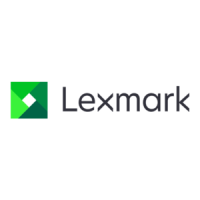• Do not use paper that has been cut or trimmed by hand.
• Do not mix paper sizes, types, or weights in the same source; mixing results in jams.
• Do not use coated papers unless they are specifically designed for electrophotographic printing.
Selecting preprinted forms and letterhead
Use these guidelines when selecting preprinted forms and letterhead:
• Use grain long for 60 to 90 g/m
2
weight paper.
• Use only forms and letterhead printed using an
oset
lithographic or engraved printing process.
• Avoid papers with rough or heavily textured surfaces.
Use papers printed with heat‑resistant inks designed for use in xerographic copiers. The ink must be able to
withstand temperatures up to 230°C (446°F) without melting or releasing hazardous emissions. Use inks that
are not aected by the resin in toner. Inks that are oxidation‑set or oil‑based generally meet these requirements;
latex inks might not. When in doubt, contact the paper supplier.
Preprinted papers such as letterhead must be able to withstand temperatures up to 230°C (446°F) without
melting or releasing hazardous emissions.
Storing paper
Use these paper storage guidelines to help avoid jams and uneven print quality:
• For best results, store paper where the temperature is 21°C (70°F) and the relative humidity is 40%. Most
label manufacturers recommend printing in a temperature range of 18 to 24°C (65 to 75°F) with relative
humidity between 40 and 60%.
•
Store paper in cartons when possible, on a pallet or shelf, rather than on the
floor.
• Store individual packages on a
flat
surface.
• Do not store anything on top of individual paper packages.
Using recycled paper and other oce papers
As an environmentally conscious company, Lexmark supports the use of recycled oce paper produced
specifically for use in laser (electrophotographic) printers. In 1998, Lexmark presented to the US government
a study demonstrating that recycled paper produced by major mills in the US fed as well as non-recycled paper.
However, no blanket statement can be made that all recycled paper will feed well.
Lexmark consistently tests its printers with recycled paper (20–100% post-consumer waste) and a variety of
test paper from around the world, using chamber tests for dierent temperature and humidity conditions.
Lexmark has found no reason to discourage the use of today's recycled oce papers, but generally the following
property guidelines apply to recycled paper.
• Low moisture content (4–5%)
• Suitable smoothness (100–200
Sheeld
units, or 140–350 Bendtsen units, European)
Note: Some much smoother papers (such as premium 24 lb laser papers, 50–90 Sheeld units) and
much rougher papers (such as premium cotton papers, 200–300
Sheeld
units) have been engineered
to work very well in laser printers, despite surface texture. Before using these types of paper, consult your
paper supplier.
• Suitable sheet-to-sheet coecient of friction (0.4–0.6)
• Sucient bending resistance in the direction of feed
7462
General information
33

